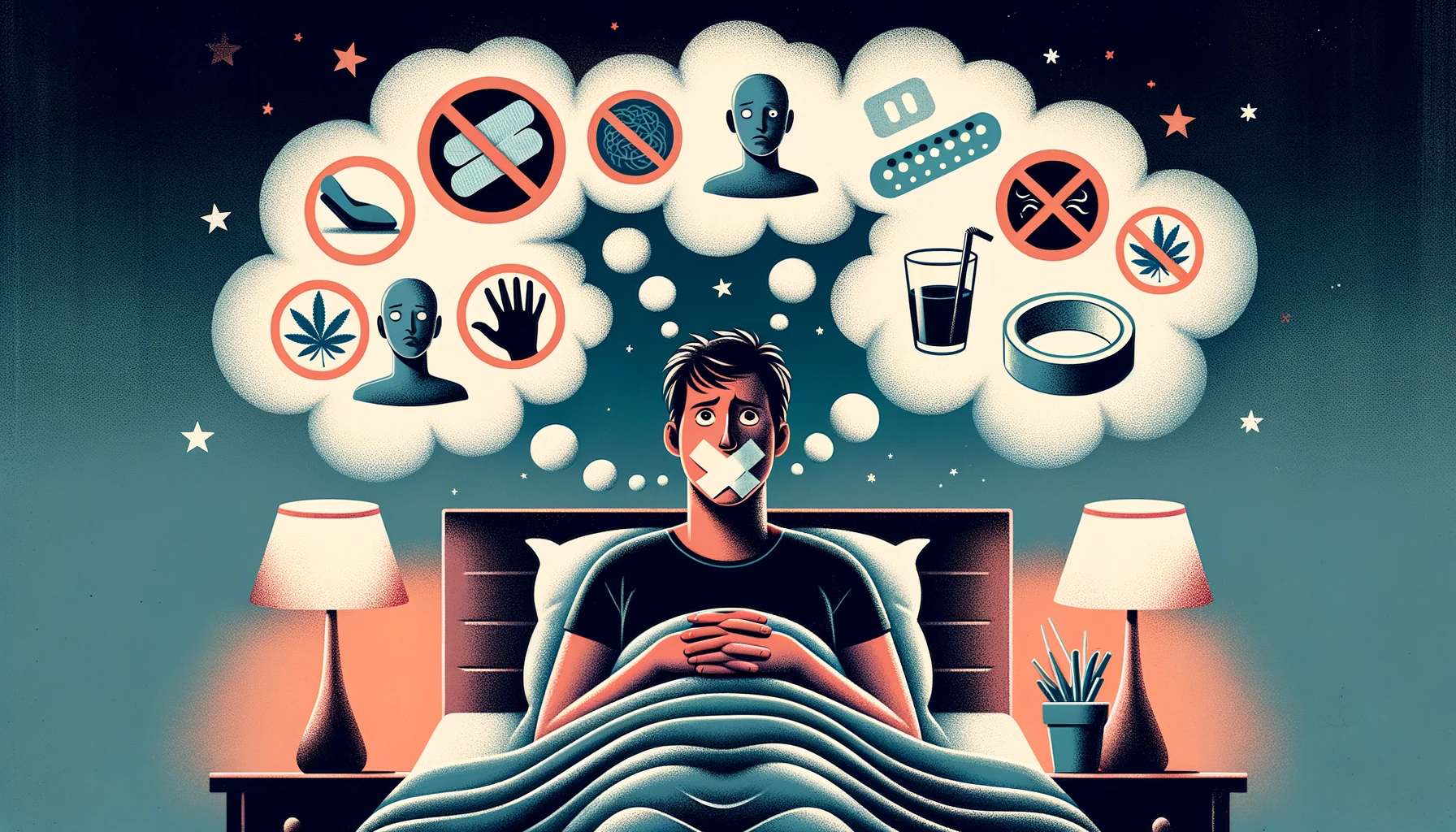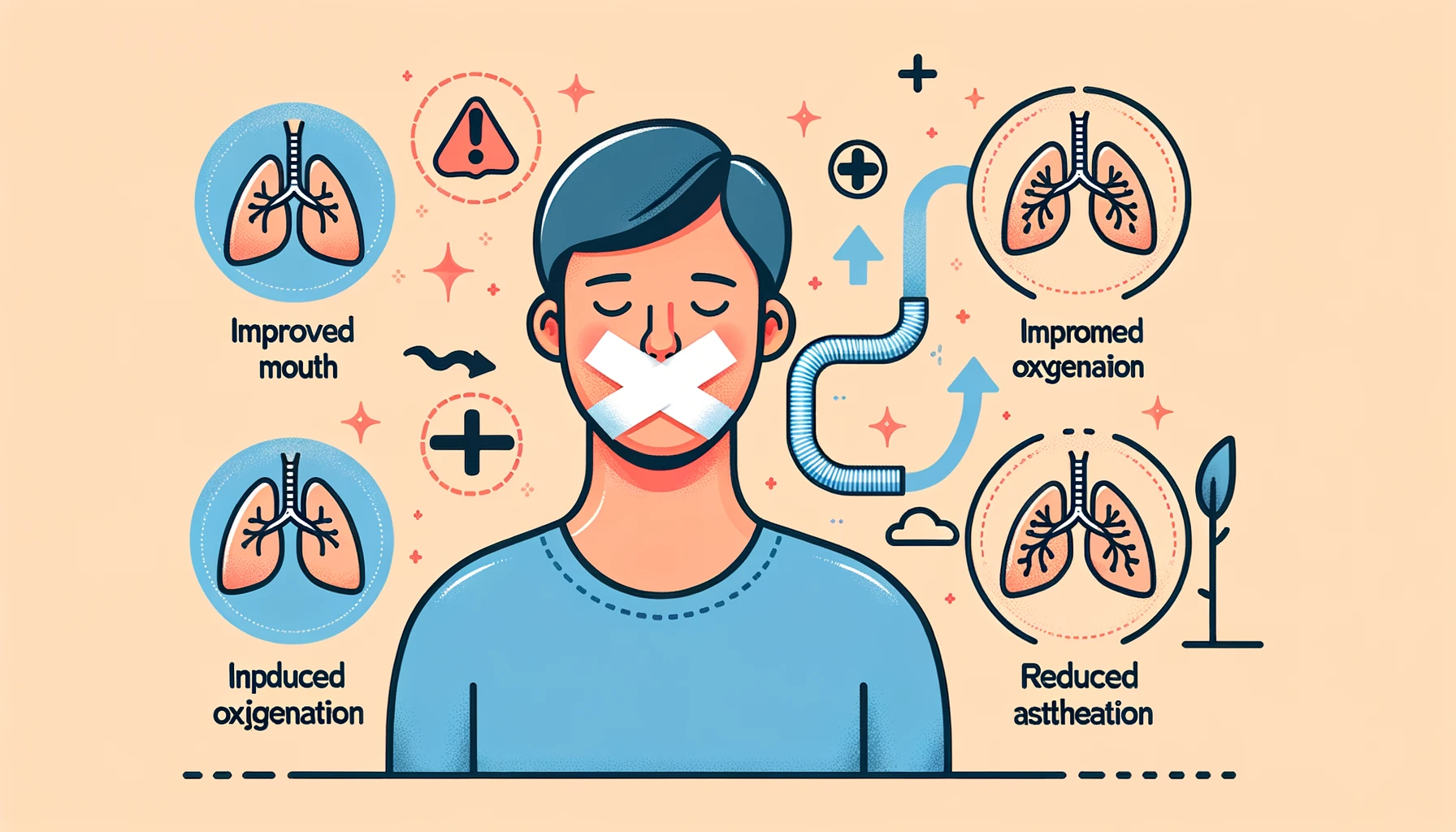In today’s world, where health hacks and wellness trends are constantly emerging, one unusual practice has garnered attention: mouth taping. This innovative technique involves applying tape over the mouth before sleep, encouraging breathing through the nose.
Advocates of mouth taping claim that it can greatly improve sleep quality, reduce snoring, and even alleviate issues like bad breath and fatigue. While limited scientific evidence supports these claims, the potential benefits of this breathing technique cannot be ignored.
By breathing through the nose, we can enjoy various advantages such as filtering out dust and allergens, moistening and warming the air, and preventing airway irritation. However, it is crucial to note that mouth taping may not be suitable for individuals with nasal congestion, respiratory blockages, anxiety, or obstructive sleep apnea.
Before engaging in mouth taping or any other wellness trend, it is important to consult with a healthcare provider. They can provide guidance on whether this practice is safe and suitable for you. Now, let’s dive deeper into the science behind mouth taping and explore its potential benefits and risks.
The Science Behind Mouth Taping
Mouth taping is a relatively new trend that has gained attention for its potential benefits on sleep quality and breathing. While there is limited scientific evidence to support its effectiveness, some studies have explored the use of mouth taping in specific contexts.
The Buteyko Breathing Technique
The Buteyko breathing technique, which incorporates mouth taping as part of its program, is sometimes used as a treatment for asthma symptoms. The technique focuses on nasal breathing and aims to reduce hyperventilation. Some studies suggest that the Buteyko program may improve the quality of life for individuals with asthma, but the effectiveness of mouth taping alone is uncertain.
One of the key benefits of nasal breathing for individuals with asthma is its potential to filter out potential triggers and keep the nasal passages moist. However, more research is needed to determine the specific benefits of mouth taping in this context.
Snoring and Sleep Apnea
Snoring and sleep apnea are two conditions that are often associated with breathing difficulties during sleep. While scientific studies on mouth taping for these conditions are limited, some evidence suggests that it may help reduce snoring and improve breathing in individuals with mild obstructive sleep apnea.
It is important to note that mouth taping may not provide benefits for everyone with these conditions, and further research is needed to establish its effectiveness and safety. Consulting with a healthcare provider is essential before considering mouth taping as a treatment option.
Conclusion
In conclusion, the science behind mouth taping is still in its early stages, with limited scientific evidence available. While some studies suggest potential benefits for conditions such as asthma, sleep apnea, and snoring, further research is needed to establish its effectiveness and safety in these contexts. Consulting with a healthcare provider is crucial before trying mouth taping, especially for individuals with underlying health conditions or concerns about breathing difficulties.
Potential Risks and Alternatives to Mouth Taping
Mouth taping may have potential risks and is not suitable for everyone. It is important to be aware of these risks before considering this practice. Reported side effects include difficulty breathing, skin irritation, anxiety, and feelings of discomfort or suffocation. To ensure your safety, it is crucial to consult with a healthcare provider before trying mouth taping, especially if you have difficulty breathing through your nose or have underlying health conditions.
Fortunately, there are alternative approaches to address mouth breathing and improve sleep quality without the potential risks of mouth taping. Consider making lifestyle changes such as reducing tobacco and alcohol consumption, as these substances can contribute to breathing difficulties during sleep. Nasal strips or dilators can also be helpful in improving airflow through the nose and reducing snoring.
Tongue and throat exercises can strengthen the muscles involved in breathing and help prevent mouth breathing during sleep. Changing your sleep position and maintaining good sleep hygiene, such as establishing a regular sleep schedule and creating a comfortable sleep environment, can also improve sleep quality and reduce snoring.
“It is important to discuss any sleep problems with a healthcare provider to determine the root cause and explore safe and scientifically proven options for better sleep.”

Alternative Approaches to Improve Sleep Quality:
- Reduce tobacco and alcohol consumption
- Use nasal strips or dilators to improve airflow
- Practice tongue and throat exercises
- Change sleep position
- Maintain good sleep hygiene
“It is important to discuss any sleep problems with a healthcare provider to determine the root cause and explore safe and scientifically proven options for better sleep.”
Does Mouth Taping Help with Specific Conditions?
Mouth taping is a popular practice that has been incorporated into the Buteyko breathing technique program, which is sometimes used to manage symptoms of asthma. The Buteyko program aims to improve asthma symptoms by promoting nasal breathing and reducing mouth breathing. While a few studies suggest that the Buteyko program may improve quality of life for individuals with asthma, the effectiveness of mouth taping alone is uncertain.
Nasal breathing is believed to benefit people with asthma by maintaining moisture in the nasal passages and filtering potential triggers. However, it is important to note that there is limited evidence specifically on the use of mouth taping for asthma management. Further research is needed to determine the effectiveness and safety of mouth taping for individuals with asthma.
In the context of sleep apnea, mouth taping has also been explored as a potential intervention. Some studies suggest that mouth taping may help reduce snoring and improve breathing in individuals with mild obstructive sleep apnea. However, more research is needed to establish the efficacy of mouth taping for sleep apnea and to determine its safety and suitability for different individuals.
The Buteyko Breathing Technique Program and Mouth Taping
The Buteyko breathing technique program incorporates mouth taping as a component to encourage nasal breathing. This technique focuses on improving breathing patterns, reducing hyperventilation, and increasing carbon dioxide levels in the body. By promoting nasal breathing and reducing mouth breathing, the Buteyko program aims to improve oxygenation and reduce asthma symptoms.
However, it is important to approach the Buteyko program and mouth taping under the guidance of a healthcare professional. They can provide proper instruction, monitor progress, and ensure that the technique is safe and suitable for individual circumstances. It is also essential to continue any prescribed asthma medications and treatments as advised by a healthcare provider.
In conclusion, while mouth taping is sometimes used in the Buteyko breathing technique program for asthma symptoms and has shown potential benefits for snoring and mild obstructive sleep apnea, more research is needed to fully understand its effectiveness and safety. Individuals interested in incorporating mouth taping into their asthma or sleep apnea management should consult with a healthcare provider to ensure proper guidance and personalized care.

Conclusion
Mouth taping, a trending practice to encourage nose breathing during sleep, has gained attention for its potential benefits on sleep quality and breathing. While scientific evidence supporting mouth taping is limited, some individuals have reported positive experiences. However, before trying mouth taping, it is crucial to consider potential risks and consult with a healthcare provider, especially if you have underlying health conditions or concerns about breathing difficulties.
Alternative approaches, such as lifestyle changes, addressing nasal congestion, and improving sleep hygiene, can also contribute to better sleep quality and address issues like snoring. These options provide safe and scientifically proven methods to optimize your sleep experience.
Further research is needed to better understand the benefits, risks, and specific conditions for which mouth taping may be suitable. By continuing to explore breathing techniques and advancements in sleep science, we strive to unlock the secrets to a restful night’s sleep and improved overall well-being.
FAQ
What is mouth taping?
Mouth taping is a practice that involves applying tape over the mouth before sleep to encourage breathing through the nose.
What are the claimed benefits of mouth taping?
Advocates claim that mouth taping can improve sleep quality, reduce snoring, and alleviate issues like bad breath and fatigue.
Is mouth taping supported by scientific evidence?
While there is limited scientific evidence to support the effectiveness of mouth taping, most of the evidence is based on anecdotal reports.
Are there any risks associated with mouth taping?
Yes, potential risks include difficulty breathing, skin irritation, anxiety, and feelings of discomfort or suffocation.
Who should not try mouth taping?
Mouth taping may not be suitable for individuals with nasal congestion, respiratory blockages, anxiety, or obstructive sleep apnea.
Are there alternative approaches to address mouth breathing and sleep quality?
Yes, alternative approaches include lifestyle changes, such as reducing tobacco and alcohol consumption, using nasal strips or dilators, and practicing tongue and throat exercises.
Can mouth taping help with asthma?
While some studies suggest that the Buteyko program, which includes mouth taping, may improve quality of life for individuals with asthma, the effectiveness of mouth taping alone is uncertain.
Is mouth taping effective for sleep apnea?
Limited studies suggest that mouth taping may help reduce snoring and improve breathing in individuals with mild obstructive sleep apnea, but more research is needed.
Should I consult a healthcare provider before trying mouth taping?
Yes, it is essential to consult with a doctor before trying mouth taping, especially if you have difficulty breathing through your nose or have underlying health conditions.
What are other ways to improve sleep quality and reduce snoring?
Other approaches include lifestyle changes, maintaining good sleep hygiene, addressing nasal congestion or respiratory allergies, and discussing sleep problems with a healthcare provider.
I’m moved by your commitment to enlightenment as I read the thought-provoking material on your website. May your way be lit up with success and new ideas.